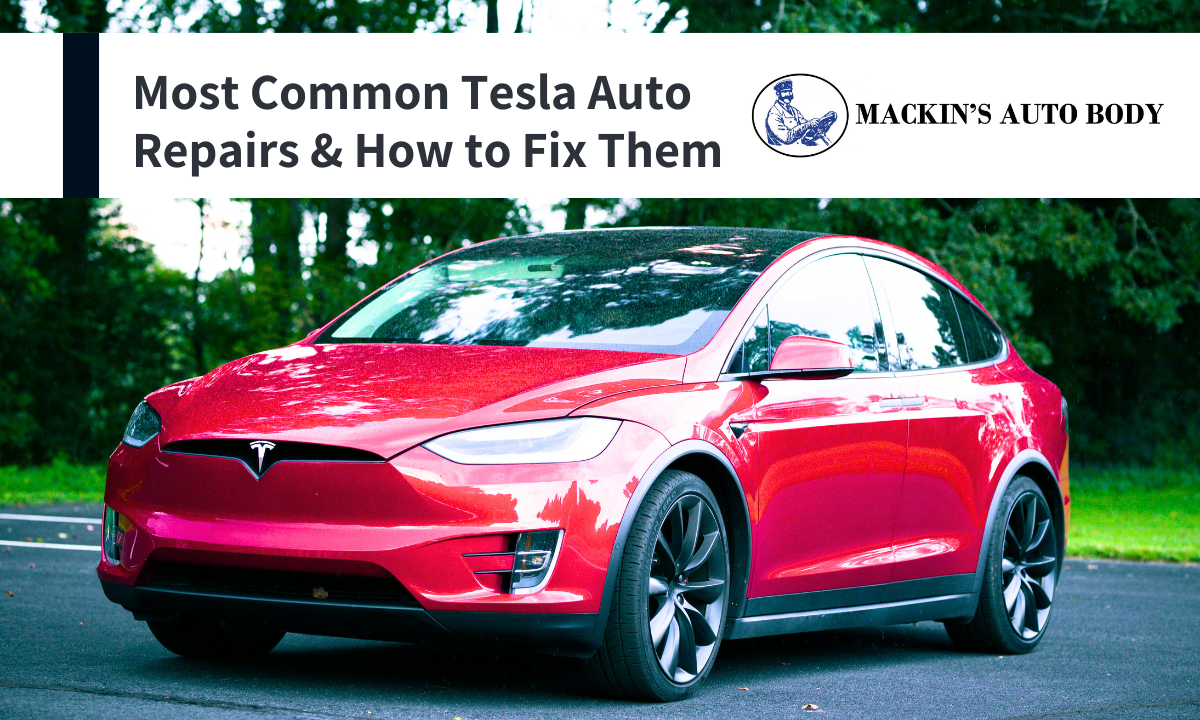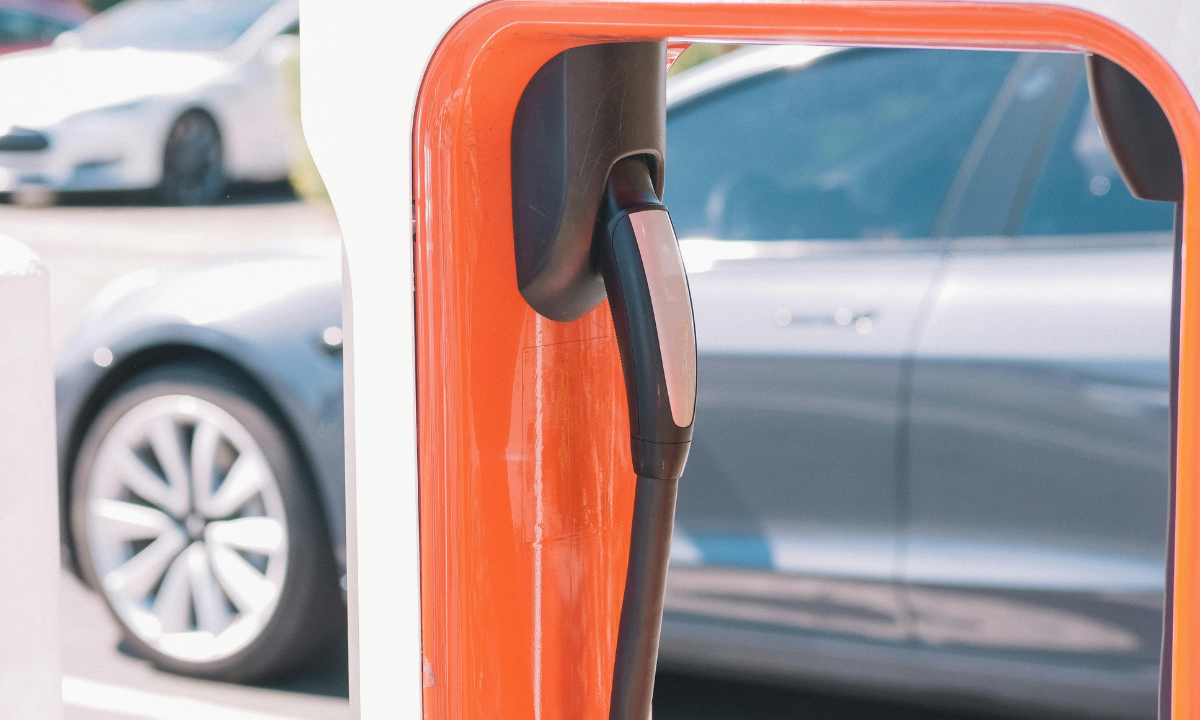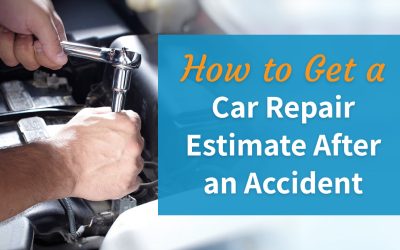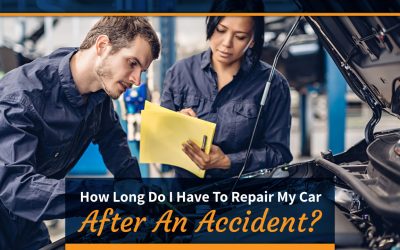
If you own a Tesla or are considering buying one, it’s important to be informed about the kinds of issues you might run into. Teslas are fun and reliable cars, and they consistently receive 5-Star Safety Ratings in crash tests performed by the NHTSA. But statistics show that Teslas are in more accidents than other auto brands.
Teslas have many unique features, including unprecedented technological integration and aluminum bodies that are designed to minimize weight and increase efficiency. The tools and methods required to fix a Tesla are very different from those needed for repairs on a standard car. So if you’re involved in an accident and need Tesla auto body repairs, it’s generally a good idea to find a Tesla Approved Collision Center like Mackin’s Auto Body whose technicians have received specialized training.

Why Drivers Choose Teslas
The popularity of electric vehicles has grown exponentially in recent years, and Tesla is without a doubt the best-selling and most well-known manufacturer of electric cars. There are many reasons drivers love Teslas, including the following:
- No gas-station stops
- No need for oil changes
- Tesla Autopilot
- An impressive battery range and built-in navigation to nearby charging stations
- Environmental benefits
- Excellent road safety
- Incredible acceleration capabilities
- The undeniable “cool factor”
1. Scratches and Paint Damage
Teslas are well-known for their soft paints and glossy finishes. While cosmetically elegant, these features can make scratches and other paint damage especially noticeable. From extreme weather, to a minor collision, to a flying pebble, paint can be damaged by environmental factors.
If an accident has left your Tesla with damaged paint, trained technicians at a Tesla Approved Collision Center can repair your vehicle using a number of restorative solutions. Smaller scratches can often be corrected using gentle abrasion to buff out the edges of the scratch. More severe paint damage generally requires a more intensive restoration process. Using color-matching software to ensure a seamless result, a Tesla collision repair shop like Mackins can prepare, prime, and repaint the affected area on your vehicle.
You can also help protect your Tesla or other vehicle from future paint damage by applying a ceramic coating. There are a variety of different ceramic coating products available, but in general they protect your car against UV damage, chemical stains, scratches, and other wear and tear. They can also add extra shine.
2. Dings and Dents
Dings and dents are common auto body problems for drivers of any make or model, including Teslas. Small dings can be caused by just about any external friction, including flying gravel, minor collisions, keying, and severe weather. On the other hand, more serious dents are often caused by a forceful impact, and they’re usually larger and more difficult to correct.
Because Teslas have aluminum bodies, they tend to require more specialized methods of dent correction. Aluminum is more pliable than steel, and requires special tools to remove dents. An aluminum dent pulling station is generally used for Teslas and other cars with aluminum bodies. Technicians at Tesla Approved Collision Centers like Mackins receive specialized training on working with aluminum and the tools required to repair dents in the material.
3. Door Handle Problems
Teslas are world famous for their ultra-modern flush door handles. While these iconic handles are stylish and aerodynamic, they have been known to fail. This can make it difficult to open the door, which is incredibly frustrating.
Common problems that occur with Tesla door handles include:
- Faulty sensors and handles that don’t automatically extend when approached
- Issues with jamming
- Misaligned handles
- Electrical problems
- Handles that don’t operate correctly in extreme cold or heat
In some cases, a malfunctioning door handle can be repaired by replacing small components such as a faulty gear or switch. In other cases, the entire handle must be replaced. You can take your Tesla to a certified repair shop to have your door handle repaired or replaced. Tesla approved facilities utilize authentic OEM (Original Equipment Manufacturer) parts rather than generic aftermarket parts.
4. Front-End Accident Damage
The front end of Teslas are unique compared to other brands, as they contain the electric powertrain. But just like other vehicles, they have metal fenders and plastic bumpers to protect the internal structures of the car.
Front-end collision damage can take many forms, including the following:
- Bent, dented, or scratched frames
- Broken headlights
- Bumper damage, from small scratches to major dents
- Suspension and alignment issues
- Transmission and engine damage
- Cracked windshields
- Hood damage
- Wheel and hub damage
Front-end collision repairs can differ substantially depending on the type and extent of damage sustained in an accident. A Tesla Approved Collision Center employs technicians who have specialized knowledge and skills when it comes to investigating and correcting Tesla damage. They can accurately evaluate all types of front-end Tesla damage – including hidden damage which may not be immediately visible – and offer specialized repair services.
5. Rear-End Accident Damage
Fender benders are one of the most common types of car accidents, regardless of the type of vehicle you drive. Rear-end damage usually occurs when another driver has made contact with the back of your car on the road and can cause serious problems for your car.
The most common types of rear-end collision damage include:
- Crushed or misaligned frames
- Bumper dents
- Trunk problems
- Broken tail lights
- Suspension issues
- Malfunctioning check-engine lights
- Fuel leaks
- Electrical issues
As is the case with front-end damage, the specific repairs your Tesla will need after sustaining rear-end damage depends on the type and severity of the damage. It’s extremely important that your repair shop is educated and skilled when it comes to correctly assessing the damage to your vehicle. That’s why it’s advisable to seek out a Tesla Approved Collision Center like Mackins, whose technicians can provide you with specialized bumper and fender repair services.

Other Non-Auto-Body Tesla Repairs
In addition to the common Tesla auto body repairs discussed above, drivers can run into problems with the electrical and mechanical systems in their cars, particularly after a collision.
Here are a few common problems with Teslas that don’t involve auto body damage:
- Battery and charging issues: While the high-capacity battery is one of the most desirable features in a Tesla, you can still run into charging port failures and reduced battery range issues.
- Software and firmware glitches: Because there’s so much technology integrated into Tesla vehicles, it’s possible to run into software and firmware issues such as MCU freezes, connectivity issues with the mobile app, and Autopilot malfunctions.
- Suspension issues: Suspension-system malfunctions or failures can occur, and Tesla drivers sometimes notice rattling and other odd noises coming from the suspension systems, which may require investigation and repair.

Has Your Tesla Been Damaged in an Accident? We’ve Got You Covered!
At Mackin’s Auto Body, we’ve been providing expert collision repair services in the Portland area since 1945. As a Tesla Approved Collision Center, our specialists undergo extensive training to provide the highest standard of Tesla repair services.
The aftermath of a collision can be frustrating and inconvenient. That’s why Mackin’s is dedicated to making the entire process as stress-free as possible. From keeping you fully updated during repairs to handling insurance claims on your behalf, you can rest assured that your Tesla is in good hands.
Contact us online to learn more about our services or visit our Tesla certified location today!
Chris Roberts is the Director of Operations at Mackin’s Auto Body, where he has been making an impact since 2018. With a career in collision repair that started in 1999, Chris brings a wealth of experience and dedication to his role. Before stepping into his current position, he served as the Assistant Operations Manager at Mackin’s Auto Body from 2013 to 2017. Chris holds a BA from Northwest Nazarene University. When he’s not ensuring everything runs smoothly at Mackin’s, you can find him skiing down snowy slopes, wake surfing on sunny days, or cheering on his daughter at her soccer games.



